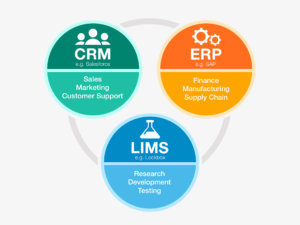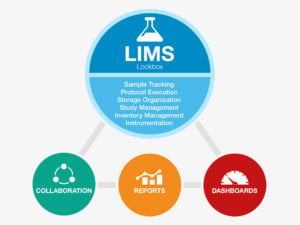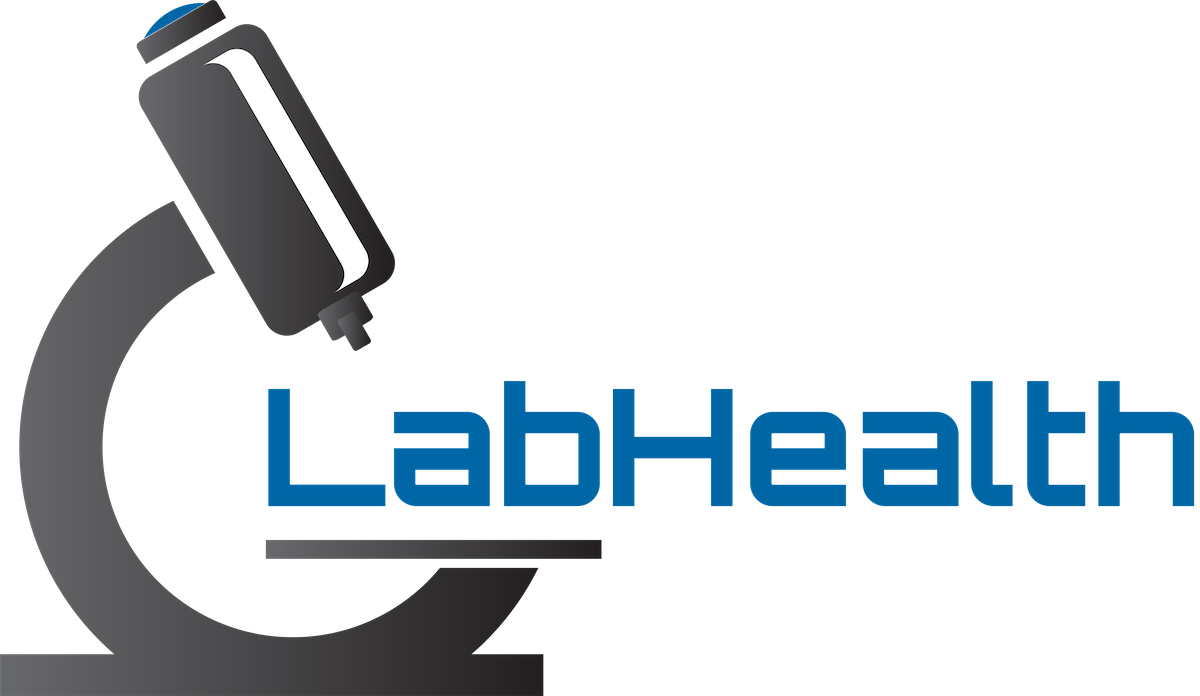Let’s start by answering the question, “what is LIMS?” LIMS stands for Laboratory Information Management System, so better phrasing would be “what is a LIMS?” A LIMS is similar in function to other data management systems used throughout the business world. In today’s digital age, organizations rely on specific software applications to manage their processes. Customer-facing departments, such as sales, marketing, and customer support, use a customer relationship management (CRM) application like Salesforce or Microsoft Dynamics. The “back office,” comprised of finance, HR, and manufacturing, uses enterprise resource planning (ERP) software such as SAP or Oracle.
Likewise, research and development (R&D) departments also have a specific software application that they use to manage the research, development, and testing of products produced by the organization. This software is called a Laboratory Information Management System, or LIMS. Laboratory Information Management Systems are widely used throughout organizations that specialize in R&D, such as universities, contract research organizations (CRO’s), biobanks, and clinical research facilities.

Now that we have a better understanding of how a LIMS fits into an organization’s framework, let’s take a closer look at what a LIMS is and what it does.
What is a LIMS system?
Also known as a laboratory information system, or laboratory management system, a LIMS is a software solution that supports key aspects of today’s complex laboratory processes. Used across a wide range of industries and research institutions, a LIMS will accurately manage and distill vast amounts of data so researchers can deliver greater insights, faster.
At the heart of it, a LIMS provides a system to track, standardize, organize, and centralize all of the data, processes, and tasks that occur in a lab.
So, how does a LIMS work? Let’s dig into the details.
What are the Core Components of a LIMS?
A good LIMS has three main components: Sample Tracking, Protocol Execution, and Storage Organization. Imagine a lab in which samples are tracked differently by different researchers, using methods varying between a pen and paper and a massive spreadsheet. It’d be extremely difficult to ensure that your data isn’t compromised by human error- missing results, errors, and differences in data collected can compound any mistake. Let’s go over the three components of a LIMS in more detail and explain how they work in tandem to benefit researchers and lab managers.
Sample Tracking with a LIMS
The primary function of a LIMS is to track a sample from the time it arrives in a laboratory, through its testing and storage. This includes recording all the data associated with the sample upon its initial accession, such as the sample’s ID, source, collection date, and quantitation information (i.e. concentration, volume, and particulate amount). As the lab sample progresses along its workflow, additional data is captured, which is also stored in the LIMS. This includes test results, derived sample data, and time-based study metrics.
In addition to capturing and tracking data specific to each lab sample, a LIMS also tracks who interacted with a sample and where the sample was throughout its lifecycle. For example, a sample may be placed in a batch or pooled together with other samples the laboratory is testing. This means that the lab sample must be tracked not only by an external barcode label affixed to the test tube but also by a chemical “index”, which allows it to be identified from the other samples in the pool. All of this valuable sample tracking information is stored in the LIMS system.
Protocol Execution with a LIMS
The second major function of a LIMS application is to drive the standardization of a lab’s workflows and underlying protocols, procedures, and steps. Ensuring that each lab tech adheres to the specific steps in a published SOP (Standard Operating Procedure) when processing a sample, regardless of who is processing the sample or running a test, is critical to obtaining an accurate and repeatable result. A LIMS supports standardization across the laboratory team by digitizing the steps in procedures and protocols, and ensuring that the entire lab staff executes the correct steps, in the correct order, when running a sample through a test.
LIMS software can manage test assignments so that when a sample arrives in a laboratory, it is immediately assigned the appropriate protocol. A LIMS can also provide a lab with more stringent protocol version control measures, granting visibility to research or clinical teams, depending on who is authorized to run the protocol. Lab test results can be recorded, sent through the appropriate approval queue and then distributed to the necessary team members via reports.
Storage Organization with a LIMS
The third critical feature in a Laboratory Information Management System is keeping track of where a sample is throughout its laboratory life cycle. Starting with the individual lab sample, the LIMS tracks where, in a particular box, the sample tube or vial is kept (for example, slot A1 or B5). Next, the system keeps track of which drawer that box is in, as well as which rack the drawer is in. Furthermore, the system tracks which shelf the rack is on, and which room the freezer is in.
This “storage hierarchy” (Sample > Position > Box > Drawer > Rack > Shelf > Freezer > Room) plays a critical role in locating samples quickly in busy laboratories. Knowing exactly where lab samples are helps research teams stay productive, organized, and efficient.
Benefits of LIMS
Data Centralization
One of the biggest benefits of LIMS software is having a centralized system to manage all of the peripheral components of a lab utilized in executing a workflow. (And this is a benefit whether you’re using a LIMS system for small laboratories or enterprise-size facilities.) Information about studies, instrumentation, and inventory can be stored in one centralized location, easily accessible to the lab team when needed.
- Using LIMS for Study Management: Lab samples are typically collected in support of a higher-level research study or project. A LIMS provides the organizational structure to group together related samples underneath the appropriate study or project. These studies typically have subjects associated with them (either human or otherwise) which can be grouped together into cohorts with associated visits. A fully functional LIMS software allows researchers to manage all this information in a single system, thus centralizing all the information for more robust data management.
- Using LIMS for Inventory Management: Integral to any lab’s ongoing operations is its reliance on lab supplies, such as reagents and chemical inventory. In order to execute protocols effectively, a laboratory’s staff must have the necessary inventory on hand. A LIMS is an important tool to provide the lab with insight into what material is on hand and what might need to be ordered. As supplies are used by personnel, a LIMS can automatically mark the supplies as consumed and trigger a re-order process – limiting the potential for error or delay and improving a team’s efficiency. A LIMS also provides lot number tracking so that the specific reagent that was used to process a lab sample is recorded in the system for future audit purposes.
- Using LIMS for Instrumentation Tracking: Every lab has a variety of instrumentation it uses on a day to day basis, including liquid handlers, QC instrumentation, and sequencers. It is critical for a lab to track the maintenance and calibration that these instruments use so that the test data generated from them is deemed accurate. A LIMS tracks all this activity and automatically alerts users when maintenance is pending or overdue. It also can track any issues that arise with lab instrumentation as they come up.
In addition to these key features, a LIMS provides the reporting, analytics, and collaboration functionality to make all the data that is captured above useful. From a reporting standpoint, a LIMS can provide information on any aspect described above. Example reports include protocol duration, sample throughput, reagent expiration, and instrument uptime. Dashboards can be set up to provide high-level trending. For example, dashboards could be created to display the number of submissions over time, lab staff utilization, and sample status.
Why is LIMS important for modern laboratories?
Today’s labs are processing and analyzing an incredible amount of information – and without a reliable LIMS system in place, it’s easy for errors to impact the speed and accuracy with which results are delivered. In some cases, this could mean that a new product launch gets delayed – but in some cases, it could be a life-saving vaccine that is urgently needed.
From a collaboration standpoint, a Laboratory Information Management System can help a lab group stay connected. Tasks can be automatically assigned to various team members as a sample is moving through a protocol. Documents are able to be annotated, shared, and commented on within the LIMS. Email and phone calls can even be captured so that communication among team members and external collaborators can be shared with everyone.

With greater efficiency and clear organizational benefits, it’s clear to see why today’s most successful laboratories rely on a laboratory information management system. The ability to organize sample tracking, workflow support, data management, and collaboration opportunities in a single piece of software, makes a LIMS the backbone of the lab.




